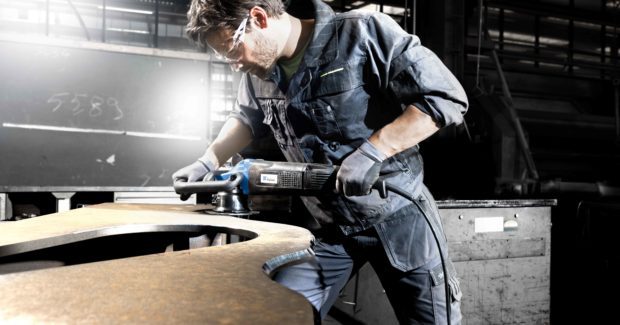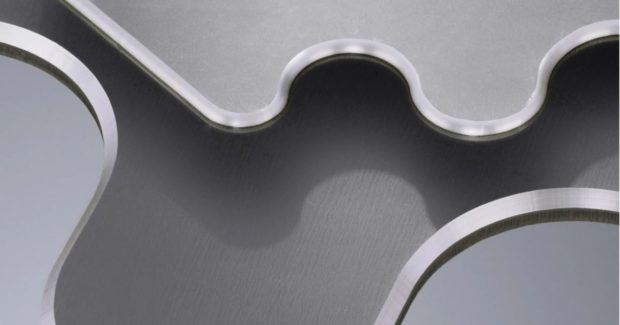The Big Benefits of Small Hand Tools
These small but powerful machines help small fabrication shops leverage their workforce to be more productive, and they complement the big, advanced production systems found in more automated factories.
Posted: October 1, 2022
CUTTING EDGE
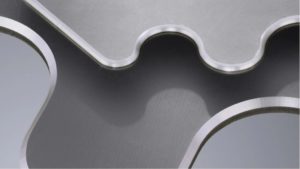
The world of sheet metal fabrication is rightly known as “heavy industry.” Big buildings, big machines, and big materials often characterize the production of sheet metal assemblies. The “bigness” of metal fabrication operations also means big outlays of capital, especially when it comes to the machinery needed to turn the large, rolled sheets of raw material into useful shapes.
Metal processing equipment ranges from “large” to “huge” depending on the working ranges and tools involved. And thanks to continual advances in their design and construction, these machines have grown more capable and versatile over time, allowing factories to expand the range of applications they can tackle while staying agile. Even so, there are times in any metal fabrication enterprise where work needs to be performed that would be inefficient or even impossible for large machinery, and this is where hand tools enter the equation.
Every factory, no matter the relative size or degree of automation, can utilize hand tools, and these could be grouped into different categories depending on the sort of work they perform.
Simple handle tools, like screwdrivers, mallets, and wrenches, depend entirely on hand-power to operate and are used for the simplest manual tasks, such as assembly or disassembly.
Power tools are hand tools that utilize a power source, most often electrical, in addition to the human operating the tool.
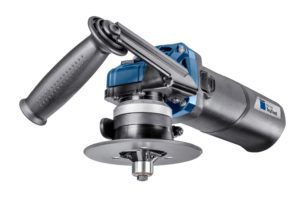
In general, large fabrication machines have evolved over time to replace the work done by hand tools in making sheet metal parts, but as we touched on earlier, sometimes it does not make sense to integrate all these processes into a larger machine. For example, by focusing on cutting two-dimensional shapes flatbed laser cutting machines can quickly achieve very high productivity, but this specialization means that secondary tools for producing 3D features cannot be easily integrated.
In a mirror image, CNC milling machines focus on being able to deliver a wide variety of tooling operations to a three-dimensional workpiece, but this unnecessarily makes programming and setting up new jobs time consuming and limits the speed and throughput of the machine process. In this context, power tools often fulfil a useful role on the factory floor, complementing the speed or capability range of bigger, more expensive and more complex machines. Even within the world of power tools for working sheet metal, we can distinguish distinct types of tools by the way they perform the work, such as whether they produce scraps in the form of chips or particles.
Take a common sheet metal fabrication process for example: beveling part edges to prepare them for welding. This step is often a necessity for the final assembly, and just as often, the step cannot be performed by the primary cutting machine that will separate the parts from the raw stock. A milling machine could separate the part from the stock and bevel the required edges, but milling processes are normally the least cost-effective way to cut sheet metal parts. A laser cutting system with 3D capability might do the trick, but again, this would be a step backwards in terms of pure cutting productivity when compared to a dedicated sheet cutting machine.
An alternative could be using a very efficient sheet-cutting laser to separate the parts, and then moving them to a high-speed milling machine to treat the beveled edges. In fact, if the quantity of parts needing this workflow is high enough, for example thousands of pieces at a time, this may be the most productive way to do the work. In smaller batches though, it becomes much more efficient to take parts cut from the sheet laser and bevel them manually with a hand tool. This bypasses the programming and setup time of the milling machine, in addition to reducing the working capital requirement to do the work. If we decide to perform this manufacturing step with a hand tool, there are two general classes of tools we turn to: grinding tools and chip-making tools.
Grinding Tools Vs. Chip-making Hand Tools
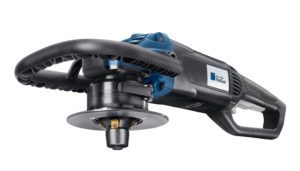
Grinding tools are more well known. Because the tools are cheap, the capital outlay to get started using them is low. Grinding tools use a spinning wheel comprised of metal, ceramic, or composite materials to remove metal from a workpiece by friction. Despite the low initial cost, these tools have serious drawbacks over the long term. The low initial cost is usually offset by the high cost of replacing the grinding media. Though individually cheap, the work that can be performed by any one wheel is extremely limited. Because all the work is done by friction, the “tool” wears down extremely fast and needs constant replacement. Cutting metal away with friction is a “hot” process, meaning heat will be introduced to the workpiece, and most of the material being removed with the grinding tool take the form of glowing-hot sparks. In addition to the safety hazards posed by flying sparks, grinding tools also normally have the spinning wheel dangerously exposed (unavoidable to allow flexibility when using the tool), but this can also mean that grinding tools are a constant potential source of injury, especially when training new operators. And because the material removed takes the form of small particulate, grinding tools will introduce large amounts of dust to the working environment, and tend to be bad for the health of both human and mechanical elements on the factory floor.
Contrast this with chip-making hand tools. These machines operate by using a sharp, hard metal tool to shear or cut through the workpiece mechanically. Shearing machines will use the mechanical shearing force of the tool to “bite” away chunks of metal, with one full slug of metal removed with each bite the tool takes. Cutting machines will use a very sharp rotating cutter to mechanically cut away shavings of metal. (Think of a router as used in the woodworking industry but designed for metal processing.) Although chip-making tools also require some training to use properly and must be handled safely by the operator, the nature of the machine design means the cutting tool can be mounted below a safety plate and the operator’s hands can be kept well-protected at all times during use. Because friction is not the means of removing metal from the workpiece, these tools do not produce flying sparks or introduce heat into the part. And because larger pieces of metal are being removed, the tools are not adding dust to the work environment that can settle into the lungs of people or the guideways of precision machinery. As a nice additional benefit, because of the work that a single hardened carbide cutter can perform, high quality chip-making tools will have a lower operational cost over the long term when compared to grinding tools.
A Major Benefit
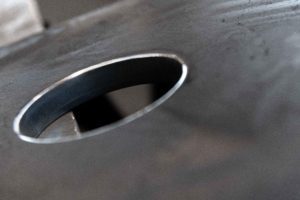
In addition to the obvious safety benefits and the boost to workplace cleanliness, chip-making hand tools offer an even larger advantage over grinding tools: consistent quality. Good quality shearing and cutting power tools will have a bearing guide surface that can be quickly and easily set by the operator to precisely produce the right depth of cut. This is regardless of whether the operation in question is beveling for weld prep, edge-breaking with a radius for safety of the finished product, or even simple deburring. The result is complete consistency from one part to the next, and from one operator to the next, as opposed to grinding, which is notoriously inconsistent and depends heavily on the individual skill of the operator.
Armed with an understanding of the machine function, it should be pretty easy to make the case for moving from grinding processes to chip-making processes in any factory. These small but powerful machines help small fabrication shops leverage their workforce to be more productive, and they complement the big, advanced production systems found in more automated factories, where the agility afforded by the hand tool helps to keep things moving, no matter how the production schedule changes. There are big benefits to be found in these small machines.
Subscribe to learn the latest in manufacturing.





